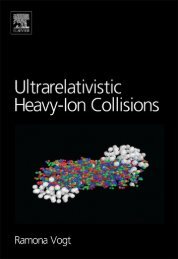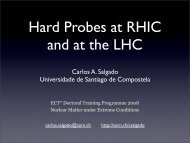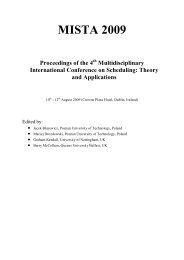Advances in perturbative thermal field theory - Ultra-relativistic ...
Advances in perturbative thermal field theory - Ultra-relativistic ...
Advances in perturbative thermal field theory - Ultra-relativistic ...
You also want an ePaper? Increase the reach of your titles
YUMPU automatically turns print PDFs into web optimized ePapers that Google loves.
408 U Kraemmer and A Rebhan<br />
where T αβ = P 0 (4δ 0 µ δ0 ν − η µν) and P 0 , the ideal-gas pressure ∝ T 4 . These identities reduce<br />
the number of <strong>in</strong>dependent structure functions to three, which may be chosen as<br />
1 (k) ≡ ˜ 0000 (k)<br />
ρ<br />
, 2 (k) ≡ ˜ 0µ<br />
µ 0 (k)<br />
ρ<br />
, 3 (k) ≡ ˜ µν µν (k)<br />
, (9.5)<br />
ρ<br />
where ρ = T 00 = 3P SB .<br />
The HTL limit is <strong>in</strong> fact universal: the <strong>thermal</strong> matter may be composed of any form<br />
of ultra<strong>relativistic</strong> matter <strong>in</strong>clud<strong>in</strong>g gravitons, which are equally important as any other<br />
<strong>thermal</strong>ized matter if the graviton background has a comparable temperature. It reads [450]<br />
ˆ 1 (k) = k0<br />
2|k| ln k0 + |k|<br />
k 0 −|k| − 5 4 , ˆ 2 =−1, ˆ 3 = 0. (9.6)<br />
As <strong>in</strong> ord<strong>in</strong>ary hot gauge theories, the entire HTL effective action is determ<strong>in</strong>ed by the<br />
Ward identities and has been constructed <strong>in</strong> [455, 456]. The three-graviton HTL vertex has<br />
moreover been worked out explicitly <strong>in</strong> [457,458], and sublead<strong>in</strong>g corrections beyond the HTL<br />
approximation have been considered <strong>in</strong> [459].<br />
From (9.6), one can formally derive an HTL-dressed graviton propagator that conta<strong>in</strong>s<br />
three <strong>in</strong>dependent transverse-traceless tensors. As the HTL propagators <strong>in</strong> gauge theories, these<br />
describes collective phenomena <strong>in</strong> the form of non-trivial quasi-particle dispersion laws and<br />
Landau damp<strong>in</strong>g (from the imag<strong>in</strong>ary part of ˆ 1 ). In the context of cosmological perturbations,<br />
the latter corresponds to the collisionless damp<strong>in</strong>g studied <strong>in</strong> [460], as we shall further discuss<br />
below.<br />
In the limit k 2 0 , k2 ≫ GT 4 , where G is the gravitational coupl<strong>in</strong>g constant, one can ignore<br />
any background curvature terms Gρ ∝ GT 4 and use the momentum–space propagator to<br />
read off the dispersion relations for the three branches of gravitational quasi-particles. One<br />
of these, the spatially transverse-traceless branch, corresponds to the gravitons of the vacuum<br />
<strong>theory</strong>. Denot<strong>in</strong>g this branch by A, (9.6) implies an asymptotic <strong>thermal</strong> mass for the gravitons<br />
accord<strong>in</strong>g to [450]:<br />
ω 2 A → k2 + m 2 A∞ = k2 + 5 × 16πGρ. (9.7)<br />
9<br />
While <strong>in</strong> a l<strong>in</strong>ear response <strong>theory</strong> branch A couples neither to perturbations <strong>in</strong> the energy<br />
density δT 00 nor the energy flux δT 0i , the two additional branches, B and C, both couple to<br />
energy flux, but only C to energy density. The additional branches correspond to excitations<br />
that are purely collective phenomena, and like the longitud<strong>in</strong>al plasmon <strong>in</strong> gauge theories,<br />
they disappear from the spectrum as k 2 /(GT 4 ) →∞. In contrast to ord<strong>in</strong>ary gauge theories,<br />
however, they do so by acquir<strong>in</strong>g effective <strong>thermal</strong> masses that grow without bound, while at the<br />
same time the residues of the correspond<strong>in</strong>g poles disappear <strong>in</strong> a power-law behaviour (<strong>in</strong>stead<br />
of becom<strong>in</strong>g massless and disappear<strong>in</strong>g exponentially) [450]. (Some sublead<strong>in</strong>g corrections<br />
to these asymptotic masses at one-loop order have been determ<strong>in</strong>ed <strong>in</strong> [461], but these are<br />
gauge-dependent and therefore evidently <strong>in</strong>complete.)<br />
For long wavelengths k 2 ∼ GT 4 , the momentum–space HTL graviton propagator exhibits<br />
an <strong>in</strong>stability, most prom<strong>in</strong>ently <strong>in</strong> mode C, which is rem<strong>in</strong>iscent of the gravitational Jeans<br />
<strong>in</strong>stability and which is only to be expected s<strong>in</strong>ce gravitational sources, unlike charges, cannot<br />
be screened. However, this <strong>in</strong>stability occurs at momentum scales that are comparable with<br />
the necessarily non-vanish<strong>in</strong>g curvature R ∼ GT 4 . The flat-space graviton propagator is<br />
therefore no longer the appropriate quantity to analyse; metric perturbations have to be studied<br />
<strong>in</strong> a curved time-dependent background.







